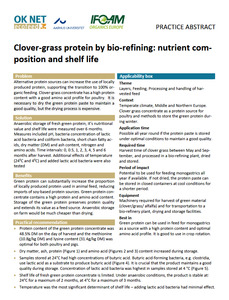{Tool} Clover-grass protein by bio-refining: nutrient composition and shelf life (OK-Net EcoFeed practice abstract). Creator(s): Steenfeldt, Sanna; Engberg, Ricarda M. and Ambye-Jensen, Morten. Issuing Organisation(s): AU - Aarhus University. OK-Net EcoFeed practice abstract. (2021)
|
PDF
- English
(Clover-grass protein by bio-refining: nutrient composition and shelf life)
169kB | |
![[thumbnail of 2025-06-03 17_24_22-Clover-grass protein by bio-refining_ nutrient composition and shelf life - PA-A.png]](/39520/3.hassmallThumbnailVersion/2025-06-03%2017_24_22-Clover-grass%20protein%20by%20bio-refining_%20nutrient%20composition%20and%20shelf%20life%20-%20PA-A.png)  Preview |
Image (PNG)
- Cover Image
- English
96kB |
Summary
Green protein can substantially increase the proportion of locally produced protein used in animal feed, reducing imports of soy-based protein sources. Green protein concentrate contains a high protein and amino acid content. Storage of the green protein preserves protein quality and extends its value as a feed source. Anaerobic storage on farm would be much cheaper than drying.
• Protein content of the green protein concentrate was 48.5% DM on the day of harvest and the methionine (10.8g/kg DM) and lysine content (31.4g/kg DM) was optimal for both poultry and pigs.
• Dry matter, ash, protein (Figure 1) and amino acid (Figures 2 and 3) content increased during storage.
• Samples stored at 24°C had high concentrations of butyric acid. Butyric acid-forming bacteria, e.g. clostridia, use lactic acid as a substrate to produce butyric acid (Figure 4). It is crucial that the product maintains a good quality during storage. Concentration of lactic acid bacteria was highest in samples stored at 4 °C (Figure 5).
• Shelf life of fresh green protein concentrate is limited. Under anaerobic conditions, the product is stable at: 24°C for a maximum of 2 months, at 4°C for a maximum of 3 months.
• Temperature was the most significant determinant of shelf life – adding lactic acid bacteria had minimal effect.
• Dried green protein has a dry matter content > 90-95%. The dry matter content of the green protein the day of harvest was 44%. To avoid microbial spoilage during anaerobic storage, reducing the water content during the bio-refining process would be desirable.
• Cooperation with a bio-refinery plant is recommended to produce the clover-grass protein concentrate, for either wet or dry storage.
| EPrint Type: | Practice tool |
|---|---|
| What problem does the tool address?: | Alternative protein sources can increase the use of locally produced protein, supporting the transition to 100% organic feeding. Clover-grass concentrate has a high protein content with a good amino acid profile for poultry. It is necessary to dry the green protein paste to maintain a good quality, but the drying process is expensive. |
| What solution does the tool offer?: | Anaerobic storage of fresh green protein, it’s nutritional value and shelf life were measured over 6 months. Measures included pH, bacteria concentration of lactic acid bacteria and coliform bacteria, short chain fatty acids, dry matter (DM) and ash content, nitrogen and amino acids. Time intervals: 0, 0.5, 1, 2, 3, 4, 5 and 6 months after harvest. Additional effects of temperature (240C and 40C) and added lactic acid bacteria were also tested |
| Country: | Denmark |
| Type of Practice Tool: | Practice abstracts |
| Keywords: | layer chickens, layers, laying hens, feeding, processing, protein, amino acids |
| Agrovoc keywords: | Language Value URI English layer chickens http://aims.fao.org/aos/agrovoc/c_12109 English feeding http://aims.fao.org/aos/agrovoc/c_2838 English processing http://aims.fao.org/aos/agrovoc/c_6195 English proteins http://aims.fao.org/aos/agrovoc/c_6259 English amino acids http://aims.fao.org/aos/agrovoc/c_342 |
| Subjects: | Animal husbandry > Feeding and growth Animal husbandry > Production systems > Poultry |
| Research affiliation: | European Union > Horizon 2020 > OK-Net EcoFeed European Union > Horizon 2020 > OK-Net EcoFeed > OK-Net Ecofeed Tools Denmark > AU - Aarhus University > Faculty of Science and Technology > Department of Animal Science European Union > Organic Farm Knowledge |
| Horizon Europe or H2020 Grant Agreement Number: | 773911 |
| Related Links: | https://organic-farmknowledge.org/tool/39520, https://anis.au.dk/, https://www.facebook.com/organicfarmknowledge/posts/290294106216564, https://twitter.com/farm_knowledge/status/1412368240685244418 |
| Project ID: | ofk |
| Deposited By: | Forschungsinstitut für biologischen Landbau, FiBL |
| ID Code: | 39520 |
| Deposited On: | 15 Mar 2021 15:05 |
| Last Modified: | 03 Jun 2025 15:24 |
| Document Language: | English |
| Status: | Published |
Repository Staff Only: item control page


